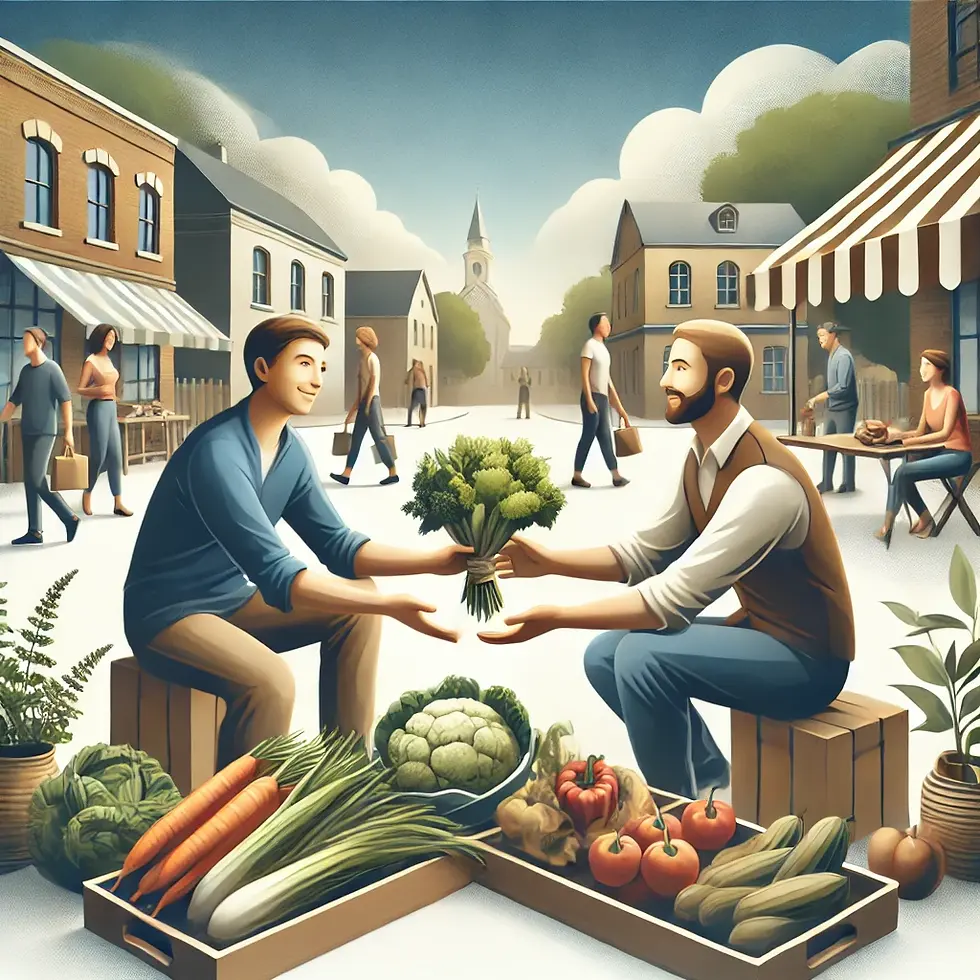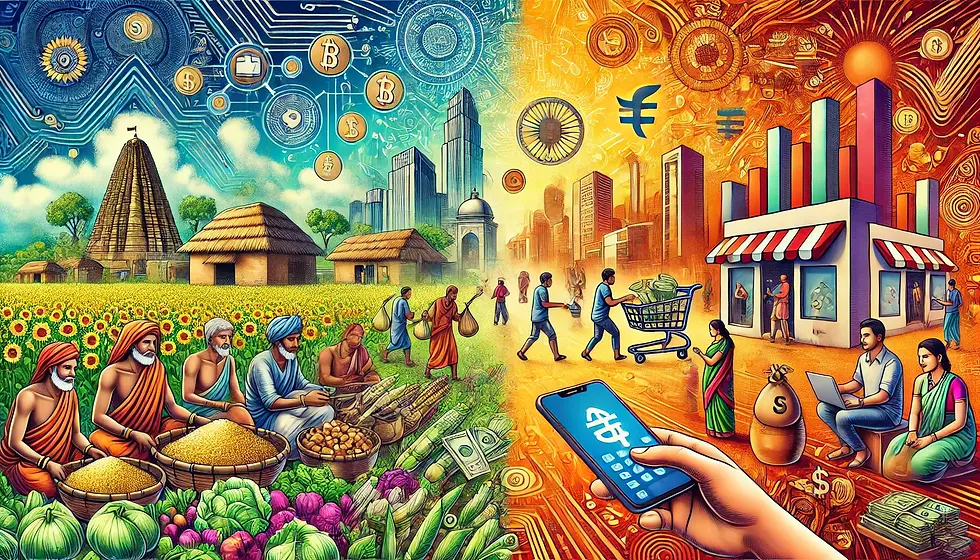Back to Basics: Why Bartering Goods and Services is Making a Comeback
- bxiworldwebsite
- Dec 26, 2024
- 5 min read
In an era dominated by digital transactions, online shopping, and cryptocurrencies, the concept of barter goods and services might seem like a relic of the past. Yet, in recent years, bartering has been making a surprising comeback. Whether driven by economic necessity, environmental concerns, or a desire for more personal connections, people are rediscovering the age-old practice of exchanging goods for goods.
The History of Bartering: A Foundation of Commerce

Bartering predates money as the earliest form of trade. Long before coins and banknotes were invented, humans relied on bartering to fulfill their needs. Farmers exchanged crops for tools, artisans traded pottery for fabric, and communities relied on this system to thrive. The barter economy laid the groundwork for modern commerce, proving that the exchange goods and services is deeply rooted in human history.
While bartering declined with the advent of currency, it never disappeared entirely. It remained a valuable tool during economic crises when cash was scarce and continues to thrive in certain communities. Today, bartering is experiencing a revival, fueled by modern challenges and innovative solutions.
Why Is Bartering Making a Comeback?
Several factors have contributed to the resurgence of barter goods and services in recent years. Here are the key drivers:
1. Economic Challenges
Economic uncertainty and inflation have made traditional monetary transactions less reliable for many individuals and businesses. Bartering offers an alternative solution, enabling people to acquire what they need without spending cash. For example, a graphic designer might exchange logo design services for a plumber’s assistance in fixing a leak. This kind of trade helps people save money while meeting their needs.
2. Sustainability and Environmental Concerns
As awareness of environmental issues grows, more people are seeking ways to reduce waste and consumption. Bartering encourages the reuse and repurposing of items, which aligns perfectly with sustainable living principles. Instead of discarding items, individuals can trade them for something they need, minimizing landfill waste and conserving resources.
3. Technological Advancements
Modern technology has revolutionized bartering. Online platforms and apps now connect people worldwide who are interested in trading goods and services. Websites like Craigslist and Facebook Marketplace, as well as specialized bartering platforms, have made it easier than ever to find trade opportunities. These digital tools blend the ancient practice of bartering with the convenience of modern technology.
4. Community Building and Personal Connections
In today’s fast-paced, often impersonal world, many people crave deeper connections. Bartering fosters a sense of community by encouraging direct interactions between individuals. Whether it’s neighbors trading tools or local artisans exchanging their crafts, bartering strengthens social bonds and builds trust.
How Bartering Works Today
barter goods and services has evolved significantly since its ancient origins. Here are some examples of how people are engaging in bartering in the modern world:
1. Local Barter Networks
Many communities have established local barter networks where members can trade goods and services. For example, a parent might offer babysitting in exchange for home repairs, or a gardener might trade fresh produce for carpentry work. These networks often operate through online platforms or community bulletin boards.
2. Online Barter Platforms
Websites and apps have made it easier to find like-minded individuals interested in bartering. Platforms like Swap.com and BarterQuest allow users to post items or services they want to trade and browse others’ listings. These tools expand the reach of bartering, enabling trades across regions and even countries.
3. Business-to-Business Bartering
Bartering isn’t limited to individuals; businesses are also getting involved. Companies often trade products or services with each other to save money or access resources they lack. For example, a marketing agency might provide promotional services for a catering company in exchange for event catering.
4. Social Media Groups
Social media platforms have become popular spaces for bartering. Local Facebook groups and neighborhood forums often facilitate the exchange of goods and services within communities. These groups are particularly valuable for trading everyday items, like furniture or appliances, without the need for cash.
The Benefits of Bartering Goods and Services
Bartering offers a range of advantages for individuals, businesses, and communities. Here are some key benefits:
1. Cost Savings
One of the most obvious benefits of bartering is the ability to save money. By exchanging goods for goods or services for services, participants can avoid spending cash altogether.
2. Flexibility and Creativity
Bartering encourages creative problem-solving. Participants often think outside the box to identify what they can offer and what they need in return. This flexibility makes it possible to strike deals that benefit both parties.
3. Sustainability
By promoting the reuse of goods, bartering reduces waste and supports environmentally friendly practices. It’s an effective way to extend the life cycle of items and contribute to a circular economy.
4. Stronger Relationships
Bartering fosters direct interactions and builds trust between individuals. Whether it’s within a neighborhood or a business network, these exchanges create stronger, more connected communities.
5. Economic Resilience
In times of economic uncertainty, bartering provides a viable alternative to cash-based transactions. It ensures that people can still access essential goods and services, even when financial resources are limited.
Challenges and How to Overcome Them
While bartering has many benefits, it’s not without its challenges. Here are some common obstacles and tips for addressing them:
1. Finding the Right Match
It can be difficult to find someone who needs what you have and offers what you need. Online platforms and local barter networks can help bridge this gap by connecting people with complementary needs.
2. Valuing Goods and Services
Determining the relative value of goods and services can be subjective. Clear communication and mutual agreement are essential to ensure fair trades.
3. Trust and Reliability
Bartering requires trust between parties. To mitigate risks, consider starting with smaller trades and building relationships over time. Using established platforms with reviews and ratings can also provide reassurance.
Conclusion: Embracing the Barter Economy
The revival of bartering goods and services is a testament to the timeless appeal of this age-old practice. In a world increasingly focused on sustainability, community, and resilience, bartering offers a practical and rewarding alternative to traditional commerce. Whether you’re trading household items, professional skills, or business resources, bartering can help you save money, reduce waste, and build meaningful connections.
As we navigate the challenges of the modern world, it’s clear that sometimes, the best solutions come from looking to the past. By embracing the simplicity and versatility of bartering, individuals and communities can create a more sustainable and cooperative future. So why not give it a try? The next time you need something, consider bartering instead of buying—you might be surprised by what you can gain.




Comments